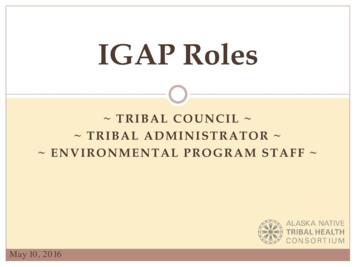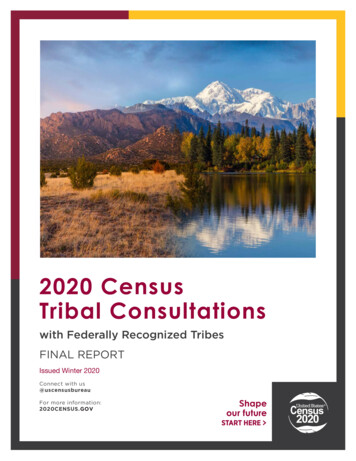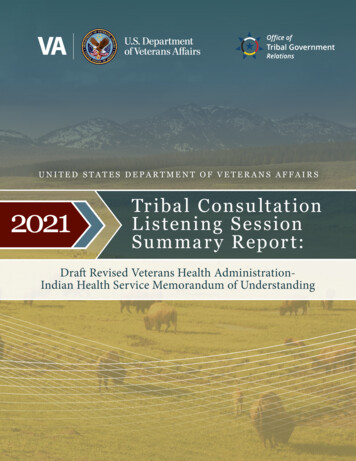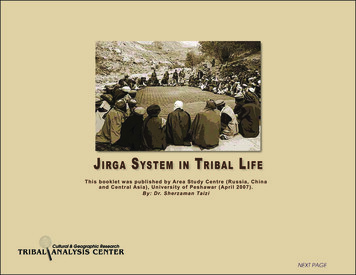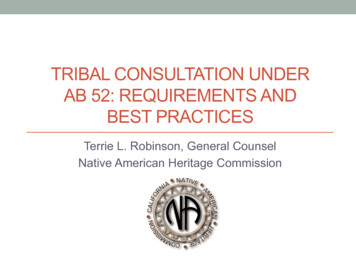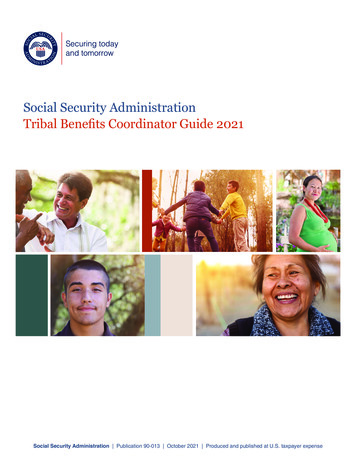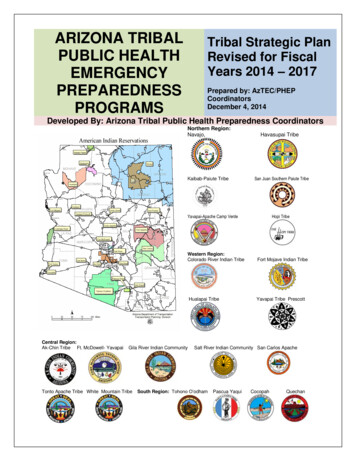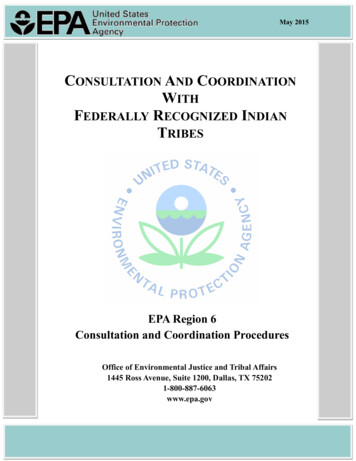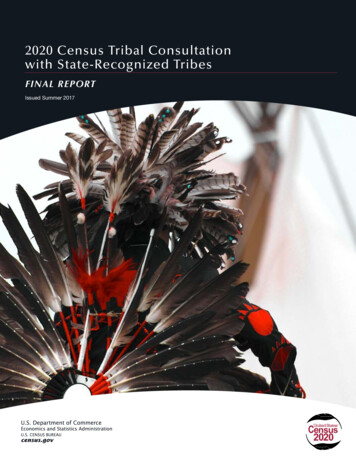
Transcription
2020 Census Tribal Consultationwith State-Recognized TribesFINAL REPORTIssued Summer 2017TM
AcknowledgementsOur gratitude is extended to the tribal delegates, American Indian andAlaska Native organization representatives, and other American Indianand Alaska Native participants who attended the tribal consultationmeeting and whose input is contained in this report. We also appreciatethe support and advice of members of the Census National AdvisoryCommittee on the American Indian and Alaska Native Populations, andthe partnership of the North Carolina Commission on Indian Affairs inpromoting attendance at the tribal consultation.Census Bureau executive leadership who participated in the consultationincluded: John H. Thompson, Director; Albert Fontenot, Acting Chief,Field Division; Jeannie Shiffer, Associate Director for Communications;Deborah Stempowski, Chief, Decennial Census Management Division; andTim Olson, Associate Director for Field Operations.Atlanta Regional Director George Grandy, Jr., and Atlanta regional staffalso participated in the tribal consultation.The following headquarters Census Bureau staff delivered shortpresentations at the meetings: Dee Alexander, Office of Congressionaland Intergovernmental Affairs; Deborah Stempowski and Maryann Chapin,Decennial Census Management Division; Roberto Ramirez, PopulationDivision; Laura Waggoner, Geography Division; Kendall Johnson,Communications Directorate; and Sydnee Chattin, Decennial ProgramsField Division.Dee Alexander (Cheyenne and Arapaho Tribes of Oklahoma), Tribal AffairsCoordinator, had primary responsibility for the tribal consultation and thefinal report.Special thanks to Office of Intergovernmental Affairs staff Van Lawrence,Bina Kawe Saafi, Melissa Bruce and Akenabah Begay for their supportand help with the tribal consultation meetings.Kauffman & Associates, Inc., (KAI) an American Indian-owned firm,was contracted to provide logistical support for the 2020 Census tribalconsultations and develop the final reports. KAI President Jo AnnKauffman co-facilitated the tribal consultation with Tim Olson.
TABLE OF CONTENTSExecutive Summary. . . . . . . . . . . . . . . . . . . . . . . . . . . . . . . . . . . 1The 2020 Census Tribal Consultation Process. . . . . . . . . . . . . . . 22020 Tribal Consultation with State-Recognized Tribes. . . . . . . . 3Census Bureau Headquarters Support. . . . . . . . . . . . . . . . . . . . . . . . 3Contractor Support . . . . . . . . . . . . . . . . . . . . . . . . . . . . . . . . . . . . . 3Background Materials. . . . . . . . . . . . . . . . . . . . . . . . . . . . . . . . . . . . 3Meeting Agenda. . . . . . . . . . . . . . . . . . . . . . . . . . . . . . . . . . . . . . . . 4Tribal Consultation Participants . . . . . . . . . . . . . . . . . . . . . . . . . . . . 4Tribal Participants. . . . . . . . . . . . . . . . . . . . . . . . . . . . . . . . . . . . .4Census Bureau Leadership. . . . . . . . . . . . . . . . . . . . . . . . . . . . . . .4Tribal Consultation Themes. . . . . . . . . . . . . . . . . . . . . . . . . . . . . 5Population Statistics . . . . . . . . . . . . . . . . . . . . . . . . . . . . . . . . . . . . 5Collection of Tribal Enrollment Data . . . . . . . . . . . . . . . . . . . . . . . .5The Question on Race . . . . . . . . . . . . . . . . . . . . . . . . . . . . . . . . . .7Coding and Classification of AIAN Responses . . . . . . . . . . . . . . . . .7Tribal Groupings . . . . . . . . . . . . . . . . . . . . . . . . . . . . . . . . . . . . . .7Considerations for Mapping Tribal Boundaries. . . . . . . . . . . . . . . . .8Statistical Boundaries for State-Recognized Tribes. . . . . . . . . . . . . .8Additional Geographies . . . . . . . . . . . . . . . . . . . . . . . . . . . . . . . . .9Enumeration Challenges. . . . . . . . . . . . . . . . . . . . . . . . . . . . . . . . .9Geography . . . . . . . . . . . . . . . . . . . . . . . . . . . . . . . . . . . . . . . . . . . 8Enumeration . . . . . . . . . . . . . . . . . . . . . . . . . . . . . . . . . . . . . . . . . . 9Feasibility of Inter net Self-Response. . . . . . . . . . . . . . . . . . . . . . .10Preferred Enumeration Approach. . . . . . . . . . . . . . . . . . . . . . . . . .10Recommended Communication Channels. . . . . . . . . . . . . . . . . . . .10Outreach Messaging . . . . . . . . . . . . . . . . . . . . . . . . . . . . . . . . . .11The Role of Social Media in Outreach to Tribal Communities. . . . . .11Building Trust with Tribes. . . . . . . . . . . . . . . . . . . . . . . . . . . . . . .12Circumstances That May Affect Recruiting. . . . . . . . . . . . . . . . . . .12Avenues for Recruitment . . . . . . . . . . . . . . . . . . . . . . . . . . . . . . .132020 Communications Campaign. . . . . . . . . . . . . . . . . . . . . . . . . . . 10AIAN Partnership Program . . . . . . . . . . . . . . . . . . . . . . . . . . . . . . . 11Recruiting for Census Jobs. . . . . . . . . . . . . . . . . . . . . . . . . . . . . . . 12
Overarching Themes. . . . . . . . . . . . . . . . . . . . . . . . . . . . . . . . . 13Challenges Faced by State-Recognized Tribes. . . . . . . . . . . . . . . . . 13The Effects of Census Data on Tribes . . . . . . . . . . . . . . . . . . . . . . . 14The Importance of Engaging Youth . . . . . . . . . . . . . . . . . . . . . . . . . 14Follow-Up Items. . . . . . . . . . . . . . . . . . . . . . . . . . . . . . . . . . . . 14Completed Follow-Up Items . . . . . . . . . . . . . . . . . . . . . . . . . . . . . . 14Next Steps. . . . . . . . . . . . . . . . . . . . . . . . . . . . . . . . . . . . . . . . . . . 16Conclusion. . . . . . . . . . . . . . . . . . . . . . . . . . . . . . . . . . . . . . . . 17Appendix: Meeting Notes from the Consultation withState-Recognized Tribes. . . . . . . . . . . . . . . . . . . . . . . . . . . . . . 19Attendees . . . . . . . . . . . . . . . . . . . . . . . . . . . . . . . . . . . . . . . . . . . 19Tribal Delegates. . . . . . . . . . . . . . . . . . . . . . . . . . . . . . . . . . . . . .19AIAN Organization Leadership . . . . . . . . . . . . . . . . . . . . . . . . . . .20Census Bureau Staff . . . . . . . . . . . . . . . . . . . . . . . . . . . . . . . . . .21Other Attendees . . . . . . . . . . . . . . . . . . . . . . . . . . . . . . . . . . . . .22Opening Ceremonies . . . . . . . . . . . . . . . . . . . . . . . . . . . . . . . . . .22Welcome. . . . . . . . . . . . . . . . . . . . . . . . . . . . . . . . . . . . . . . . . . .22Opening Remarks . . . . . . . . . . . . . . . . . . . . . . . . . . . . . . . . . . . .22Overview of the Agenda. . . . . . . . . . . . . . . . . . . . . . . . . . . . . . . .24Introductions and Open Discussion. . . . . . . . . . . . . . . . . . . . . . . .24Overview of Planning for the 2020 Census. . . . . . . . . . . . . . . . . . .27Population Statistics Discussion. . . . . . . . . . . . . . . . . . . . . . . . . .33Geography Discussion. . . . . . . . . . . . . . . . . . . . . . . . . . . . . . . . .41Enumeration Discussion. . . . . . . . . . . . . . . . . . . . . . . . . . . . . . . .462020 Communications Discussion. . . . . . . . . . . . . . . . . . . . . . . . .49Partnership Discussion. . . . . . . . . . . . . . . . . . . . . . . . . . . . . . . . .53Job Recruitment Discussion. . . . . . . . . . . . . . . . . . . . . . . . . . . . .55Wrap-Up, Overview, Clarification, and Next Steps . . . . . . . . . . . . .58Closing Prayer. . . . . . . . . . . . . . . . . . . . . . . . . . . . . . . . . . . . . . .59Introductory Remarks. . . . . . . . . . . . . . . . . . . . . . . . . . . . . . . . . . . 22Presentations, Discussion, and Testimony. . . . . . . . . . . . . . . . . . . . 24Closing Remarks . . . . . . . . . . . . . . . . . . . . . . . . . . . . . . . . . . . . . . 58Action Items . . . . . . . . . . . . . . . . . . . . . . . . . . . . . . . . . . . . . . . . . 59
Final ReportTM
Executive SummaryIn recognition of the importance of engaging with all Indigenous groups to promotean accurate count in the 2020 Census, the Census Bureau held a tribal consultationspecifically designed for state-recognized tribes. The objectives of the tribal consultationmeeting included:u encouraging open communication between the Census Bureau and tribes,u gathering tribal input on how to effectively implement programmatic and operationalactivities,u recording and addressing outcomes and recommendations, andu providing information on and answering questions about Census Bureau programsand the 2020 Census.The meeting agenda was structured according to the six main topics covered in the 2020Census Tribal Consultation Handbook, which include:u population statistics,u geography,u enumeration,u the 2020 Communications Campaign,u the AIAN Partnership Program, andu recruiting for Census jobs.Through dialogue about these topics, several overarching themes organically emerged.These high-level topics include:u unique challenges faced by state-recognized tribes,u the implications of census data on tribal programs and planning, andu a need to actively involve younger generations in promoting and conducting thecensus in their tribal communities.This report summarizes the responses by topic from state-recognized tribal leadership.Next, the report explores several overarching themes covered during the consultation thattranscend the agenda topics. The report concludes by outlining next steps based on followup items identified during the tribal consultation. For reference, the notes from the tribalconsultation are included as an appendix.State-Recognized Tribes Tribal Consultation Final Report 1
The 2020 Census TribalConsultation ProcessTribal consultation is a forum for meaningful dialogue in the context of the government-togovernment relationship between the federal government and tribes. It emphasizes opencommunication around upcoming decisions, policies, or actions that may impact tribes. Forthe decennial census, tribal consultation helps to:u involve tribes in decision-making,u give tribal governments an open forum to raise issues or concerns,u enhance communication between the Census Bureau and tribal leadership,u strengthen partnerships between the Census Bureau and tribes, andu identify action items or issues that need further input.Tribal consultation is a vital component in ensuring that everyone is counted in thedecennial census. It is the basis of the Census Bureau’s partnership with tribal governmentsand the springboard for planning an accurate count of American Indians and Alaska Natives(AIANs) in the decennial census. To honor the government-to-government relationshipbetween the federal government and tribes and to ensure tribal input is incorporated intothe design and execution of the 2020 Census, the Census Bureau began consulting withtribal leaders five years in advance of the decennial census.Guided by its own and the Department of Commerce’s tribal consultation policy, theCensus Bureau executed an initial round of tribal consultations, which included eightmeetings and a national webinar, followed by a second round of nine meetings as part ofthe 2020 American Indian and Alaska Native (AIAN) Program. During this second round ofconsultations, the Census Bureau held a tribal consultation specifically for state-recognizedtribes.The 2020 AIAN Program leads the Census Bureau’s tribal consultation process. Thisprogram exists to raise awareness of the purpose and importance of the census amongtribal audiences. The AIAN Program emphasizes outreach to AIANs living on tribal lands—ahistorically undercounted population—to promote a complete, accurate count of AIANs inthe 2020 Census.2 UNI T EDS TATES C E NS U S B U R E A U
2020 Tribal Consultation withState-Recognized TribesWorking with and achieving accurate counts for all Indigenous groups in the United Statesis a priority for the Census Bureau. The Census Bureau prioritized a tribal consultationspecifically with state-recognized tribal governments because tribes without federalrecognition face a unique set of circumstances. In partnership with the North CarolinaCommission on Indian Affairs , the Census Bureau hosted a tribal consultation intendedspecifically for state-recognized and non-recognized tribes on September 1, 2016, inRaleigh, NC.CENSUS BUREAU HEADQUARTERS SUPPORTAn invitation letter from Census Bureau Director John H. Thompson was sent electronicallyto 67 state-recognized tribes. Background information and follow-up correspondence werealso sent to the leadership of these tribes.CONTRACTOR SUPPORTThe Census Bureau contracted with Kauffman & Associates, Inc. (KAI), an AmericanIndian-owned professional services firm, to assist with planning and executing the tribalconsultation.KAI researched tribes and tribal organizations that could be ideal partners in planning theconsultation, and collaborated with the Census Bureau to coordinate the consultations.KAI sent the initial invitation and additional notifications to tribal leadership, helped arrangetravel, and developed the meeting agenda. Onsite at the consultation, KAI provided logistic,registration, and note-taking services; developed summary notes following the tribalconsultation; and created the final report.BACKGROUND MATERIALSThe 2020 Census Tribal Consultation Handbook, which was sent to tribes prior to theconsultation, contained context information on six tribal consultation topics to help tribaldelegates prepare responses. Each topic was accompanied by discussion questions.Also included in the handbook were a copy of the “Dear Tribal Leader” letter from DirectorThompson, two frequently asked questions about the census with accompanying answers,a brief history of the decennial census as it relates to AIANs, and an overview of theplanning for the 2020 Census. Instructions for alternative ways of submitting commentswere also included for those who were unable to attend the consultation in person, but stillwanted to contribute.State-Recognized Tribes Tribal Consultation Final Report 3
MEETING AGENDAThe meeting agenda was structured according to the six main topics covered in the 2020Census Tribal Consultation Handbook. The agenda was designed with a flexible structure tostimulate discussion about the tribal consultation topics and gather tribal input, concerns,questions related to the 2020 Census.The tribal consultation opened with a brief presentation from the Census Bureau thatsummarized planning for the 2020 Census, followed by introductions and an opendiscussion period. Next, the Census Bureau delivered a brief presentation for eachof the six topics, with a discussion period following each presentation. Each CensusBureau presentation concluded by posing discussion questions from the 2020 CensusTribal Consultation Handbook. Feedback from tribes during previous 2020 Census tribalconsultations answered some of the Census Bureau’s initial requests for information andreshaped some of the more complex questions. Therefore, the questions asked at this tribalconsultation did not precisely match those printed in the handbook.TRIBAL CONSULTATION PARTICIPANTSParticipants at the consultation included tribal leaders and official tribal delegates,representatives of tribes and AIAN organizations, and representatives of Census Bureauheadquarters and the Atlanta regional office.Tribal ParticipantsThirty-eight tribal delegates and AIAN organization representatives attended the tribalconsultation, representing 24 state-recognized tribes and seven AIAN organizations. Someparticipants attended in multiple capacities by representing a tribe and an organization, andsome tribes and organizations were represented by multiple participants.Census Bureau LeadershipCensus Bureau executive leadership who participated in the tribal consultation included:u John H. Thompson, U.S. Census Bureau Director;u George Grandy, Jr., Atlanta Regional Director;u Jeannie Shiffer, Associate Director for Communications;u Tim Olson, Associate Director for Field Operations;u Deborah Stempowski, Chief, Decennial Census Management Division; andu Albert Fontenot, Acting Chief, Field Division.Headquarters staff from each of the programmatic areas represented in the agendaattended the tribal consultation and delivered brief presentations to inform discussionswith tribal leadership. Census Bureau staff from the Office of Congressional andIntergovernmental Affairs, as well as the Atlanta Regional Office, were also involved.4 UNI T EDS TATES C E NS U S B U R E A U
Tribal Consultation ThemesThis portion of the report summarizes by topic the responses from state-recognized triballeadership. The sections below correspond with each of the six agenda topics, whichinclude:u population statistics,u geography,u enumeration,u the 2020 Communications Campaign,u the AIAN Partnership Program, andu recruiting for Census jobs.Subsections under each topic summarize tribal responses to a particular discussionquestion for each topic.POPULATION STATISTICSData for the AIAN population come from the census race question. The Census Bureaucollects information according to the U.S. Office of Management and Budget’s (OMB)definition of American Indian or Alaska Native, which refers to a person who has originsin any of the original peoples of North and South America (including Central America) andwho maintains tribal affiliation or community attachment. Data for the AIAN populationinclude people who mark the AIAN checkbox or write in the name of an American Indian,Alaska Native, or Central/South American group. To produce high-quality data for the AIANpopulation, the Census Bureau uses a coding and classification process through whichindividual write-in responses for AIAN tribes, villages, corporations, and other self-reportedAIAN identities are coded and tabulated. The Census Bureau inquires with tribes aboutpossible changes to the way their tribal citizens self-identify. Feedback on the coding andclassification list is essential to ensure the population statistics produced for the AIANpopulation meet tribal needs.Collection of Tribal Enrollment DataIn the lead-up to the 2010 Census, some tribes requested that the Census Bureau explorethe possibility of gathering data on the tribal enrollment status of individuals who selfidentify as AIAN—a separate and distinct concept from racial identification as AIAN.The Census Bureau explored the possibility of collecting tribal enrollment data to fulfilla commitment to test a potential tribal enrollment question for the 2020 Census. Otherfederal agencies, such as the U.S. Department of Housing and Urban Development, havealso requested that the Census Bureau gather tribal enrollment data. Throughout the 2020State-Recognized Tribes Tribal Consultation Final Report 5
Census tribal consultations, however, many tribes, as well as the National Congress ofAmerican Indians (NCAI), expressed concerns about the feasibility of capturing accuratetribal enrollment numbers through a census that relies on self-response. Based on thisfeedback, the Census Bureau will not include a tribal enrollment question in the 2020Census, but will finish the tribal enrollment testing to fulfill the commitment. The testing willalso inform potential future requests from tribal leaders or federal agencies to collect similardata.Discussion question: If the Census Bureau collected data on tribal enrollment, wouldyour tribe or village use those data? If yes, how?Tribal ResponseLeadership from state-recognized tribal governments expressed opposition to thecollection of tribal enrollment data, citing the following reasons.u Tribal enrollment numbers gathered through self-identification would not matchtribal rolls.u Gathering tribal enrollment data infringes on tribal sovereignty, since tribes alonehave the right to determine their own enrollment.u Maintaining tribal enrollment records is the responsibility of sovereign tribal nations,not the duty of the federal government.u The Census Bureau cannot verify the tribal enrollment data gathered withouttribes sharing their confidential rolls with the Census Bureau, and, similarly, thetribes cannot verify the census data without the Census Bureau sharing individualresponses to the census, which are also confidential.u Gathering tribal enrollment data through the census may set a precedent thatencourages other federal agencies to ask to view tribes’ proprietary enrollmentrecords.u If tribal enrollment data gathered by the census are perceived as more credible thantribal enrollment records, this would place a burden of proof on tribes.A recommendation gathered from the tribal consultation is for the Census Bureau towork one-on-one with tribes that have requested tribal enrollment data to publish thatinformation.6 UNI T EDS TATES C E NS U S B U R E A U
The Question on RaceThe Census Bureau has been testing new formats for the race question to elicit detailedresponses.Discussion question: How would you like to report your race on a census form?Tribal ResponseThe question wording and format must encourage people to report multiple races byproviding clear instructions and ample write-in space. Examples of write-in responsesshould be specific to encourage the reporting of detailed tribal identities. Enumeratorsshould be trained to ask AIAN respondents specifically with which tribe they identify.It is important for tribal governments to conduct outreach to their citizens about how toself-identify on the census form to ensure that responses will be coded and tabulatedappropriately.Coding and Classification of AIAN ResponsesPeople often write in different responses about their racial identities, though they areattempting to provide the same high-level information. For example, tribal citizens maywrite the acronym for their tribe’s official name, or they may write a response in their Nativelanguage. The Census Bureau maintains a code list that includes known names for federallyrecognized, state-recognized, and non-recognized tribal groups, to ensure that write-inresponses are classified and tabulated correctly.Discussion question: Please share updates and any other feedback regarding yourcoding and classification preference for the 2020 Census.Tribal ResponseThe Southeastern Mvskoke Nation, Inc., recently changed its official name from the StarClan of Muscogee Creeks. This change needs to be reflected in the code list.Tribal GroupingsDiscussion question: Please share updates and any other feedback regarding yourcoding and classification preference for the 2020 Census.Tribal ResponseThe term Algonquin should be included among the Wampanoag classification on the codelist.State-Recognized Tribes Tribal Consultation Final Report 7
GEOGRAPHYIn addition to producing total counts at the national level, the Census Bureau tabulatesdata for all households located within specific geographic areas, such as reservations orcounties. To ensure the correct households are counted toward a particular geography,the Census Bureau must have up-to-date boundaries and accurate housing unit locations.Statistical areas can be defined when a tribe needs data for a certain area that does nothave legally defined boundaries. The Participant Statistical Areas Program provides anopportunity for tribes to define and update statistical boundaries. The Census Bureauworks with tribes to accurately define tribal geographies that ensure useful data arereturned to tribes. The Census Bureau also coordinates with state governments to workwith state-recognized tribes in ensuring their geographic boundaries are up-to-date.Considerations for Mapping Tribal BoundariesDiscussion question: For which geographic areas does your tribe use data mostoften?Tribal ResponseConsultation with individual tribes is key to understanding their perceptions of their triballands. Many tribes may understand the boundaries of their lands independently of stateor county boundaries, which were drawn long after most tribal communities established asense of place.Statistical Boundaries for State-Recognized TribesTribes without trust lands, reservations, or other legal areas can define statistical areaswithin which to count their populations. Statistical areas can also be used to capture aconcentrated population of tribal citizens living off tribal lands. State Designated TribalStatistical Areas (SDTSAs) or Census Designated Places (CDPs) are statistical areas thatmay be designated for state-recognized tribes.Discussion question: Has your tribe used data from geographic statistical areas, suchas SDTSAs or CDPs?Tribal ResponseState-recognized tribes face unique challenges in designating statistical areas. To definean SDTSA, the encompassing state must formally recognize the tribe as existing within itsboundaries. Sappony’s geographic situation illustrates these unique challenges. The tribeis located in North Carolina and Virginia, but is only recognized by North Carolina, whichprevents the designation of an SDTSA to capture the tribe’s population in Virginia.8 UNI T EDS TATES C E NS U S B U R E A U
Additional GeographiesDiscussion question: Are there geographic areas that the Census Bureau does notcurrently map that would be helpful to your tribe?Tribal ResponseFor tribes with tribal schools, designating a statistical area based on the school districtcould provide the tribe with useful data.ENUMERATIONThe 2020 Census will offer several response options. The primary response option will beInternet self-response through a secure website. The Census Bureau will also offer optionsto respond through a paper questionnaire or over the telephone. For places where otherresponse options are not feasible, and to follow up with households that do not selfrespond, the Census Bureau will conduct in-person enumeration by sending interviewersto knock on doors. The Census Bureau would like individual tribal input on the best way toenumerate each tribal community.Enumeration ChallengesEach enumeration method has associated challenges, and the Census Bureau facesoverarching challenges to enumerating AIAN populations, such as a fear that individualinformation collected through the census will be released or used to the detriment oftribal people. In spite of these challenges, the Census Bureau needs to work with tribes todetermine how to count everyone.Discussion question: How can we ensure that every person within a household iscounted, especially if there is more than one family living in the home?Tribal ResponseChallenges identified include counting the homeless, as well as community members whofrequently move residences and do not have a permanent home. Capturing the number ofresidents in overcrowded or multi-family homes also presents a challenge, since peoplemay fear being penalized for violating housing regulations.Tribal delegates emphasized the importance of hiring enumerators locally who understandtheir communities and are trusted by community members. The Census Bureau shouldprioritize local expertise, such as fluency in the tribe’s Native language, when recruitingenumerators, and ensure enumerators understand that citizens of state-recognized tribescan and should self-identify as AIAN.State-Recognized Tribes Tribal Consultation Final Report 9
Feasibility of Internet Self-ResponseDiscussion question: Is Internet connectivity an issue in your area?Tribal ResponseInternet connectivity is often an issue in rural tribal areas. For many North Carolina tribes,high-speed Internet is not widely available. Many tribal homes lack Internet accessand some lack computers. Since connectivity is often available through mobile data onsmartphones, a mobile app or mobile-friendly website was recommended.Preferred Enumeration ApproachDiscussion question: Could you share with the Census Bureau your preferredenumeration approach for the 2020 Census?Tribal ResponseSeveral tribal delegates reported that in-person enumeration worked well for their tribes inthe past, especially when enumerators worked in close partnership with tribal offices.In-person enumeration in a group setting, such as at an elders’ meeting, was discussedas an effective approach. Census Bureau regional offices will work with tribes individuallyto understand their preferred enumeration approach, and implement this strategy wherefeasible.2020 COMMUNICATIONS CAMPAIGNThe Census Bureau will conduct a large-scale communications campaign to raiseawareness about the census and encourage self-response. The campaign will involvetraditional media and partnerships. It will incorporate significantly greater use of socialmedia, as this platform has grown immensely. Culturally relevant messages targeted towardAIAN audiences will run in the media outlets most watched, listened to, and read by AIANpopulations and on websites most visited by the target audien
give tribal governments an open forum to raise issues or concerns, u enhance communication between the Census Bureau and tribal leadership, u strengthen partnerships between the Census Bureau and tribes, and u identify action items or issues that need further input . Tribal consultation is a vital component in ensuring that everyone is counted .
